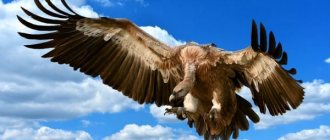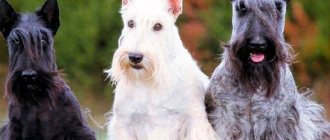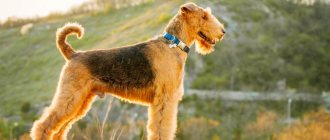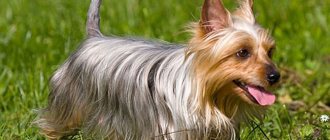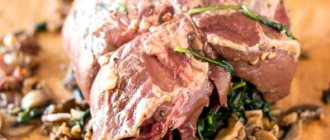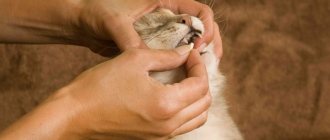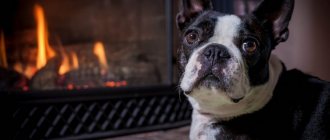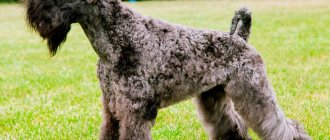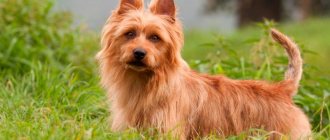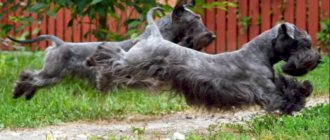| Type |
|
| Size | large (26-50kg) |
| Main features |
|
| Included in |
|
| Frequent illnesses |
|
| Intelligence | 85% |
American Staffordshire Terrier
American Staffordshire Terrier dogs are very menacing on the outside. A muscular, stocky figure, square jaws, a stern expression of the muzzle, piercing eyes - all this makes a terrifying impression. It is not surprising that strangers are afraid of amstaffs. But those who know them closely assure that inside this animal is affectionate and gentle.
Owners of Amstaff dogs confess their love for their pets and call them kind and obedient. They believe that this is a universal breed. Under one short-haired coat, the American Terrier is an excellent guard, athlete and companion. And a dog becomes a problem if he was not given attention, was raised incorrectly, or was deliberately made into an aggressive monster. Unfortunately, there are also such “lovers” of animals.
Let's see why there are such conflicting opinions about the Staffordshire Terrier breed? Who is this amstaff - a sweet creature or an uncontrollable evil beast that is dangerous to keep in the city.
Main settings
People who are seriously interested in Staffordshire Terrier dogs should familiarize themselves with the parameters of representatives of this breed in advance.
Height and everything
Staff is a rather small dog and grows only 40-45 centimeters. Some males can reach 50 centimeters in height. Such dogs weigh on average about 25-30 kilograms.
Adult American Staffies can look quite menacing. The appearance of such dogs speaks of their strength and determination. Despite their relatively small size, they have developed and powerful muscles. Also, such dogs are quite playful, which is why they are sometimes used for hunting.
Head
Representatives of the Staff dog breed have a fairly wide, but not long, medium-sized head. On top are slightly raised and erect ears. Sometimes they hang down, but this is extremely rare.
Dogs have large eyes. They are painted gray or black, sometimes with a blue or blue tint. The nose of dogs is not very large and has a dark color. Cheekbones are clear and well defined. The dog's jaws are powerful, especially the lower one.
Body, tail and paws
Prick ears are one of the characteristics of the breed.
Although the Amstaff is not a large dog, its chest is quite wide. The belly of such dogs is tucked up and does not hang down much.
The forelegs are perfectly straight and widely spaced. The hind legs are larger than the front legs due to well-developed muscles. The tail of Staffordshire Terriers is quite short, especially given their wide build.
Coat
Representatives of this breed have a short coat type. Most often the predominant color is fawn with a red or brown tint. Sometimes there are dogs with spotted or brindle colors.
Additional Information! According to the accepted standard, American terriers can have any color. However, despite this, it is undesirable for white to predominate. Such albino dogs are not suitable for participation in exhibitions.
History of the American Staffordshire Terrier breed
The Staffordshire Terrier breed originated in England around the mid-nineteenth century. It became American later. The ancestors of modern Amstaffs were real gladiators. Fighting dogs, mostly bulldogs or mastiffs, were entered into the ring against bulls, boars and bears. However, wild animals often prevailed. Heavy dogs lost because of their clumsiness and slowness.
At the very beginning of the 19th century, breeders decided to improve the qualities of fighters to make fights more dynamic. Massive dogs were crossed with nimble, fast and smart terriers. This is how new breeds appeared - the ancestors of bull terriers. Its representatives inherited the best features of their predecessors: strength, courage, speed and cunning. Get to know a small but very fighting dog - the Jack Russell Terrier
In 1835, bullfighting was banned in England, after which dog fights became even more popular, and a new fighting breed was in demand. The dogs were called pit bull terriers and were sometimes called Staffordshire terriers. However, by the end of the 19th century, dog fighting was also banned in the United Kingdom. Then the descendants of terriers and bulldogs set off to conquer the New World.
In America, the breed found a new calling. Breeders began to develop in dogs not so much fighting qualities, but rather protective qualities, as well as intelligence and devotion to the owner. Staffordshire Terriers began to protect farmers' lands from wild predators. Michigan dog handlers have been especially successful in this matter. As a result of their efforts, a dog appeared outwardly very formidable, like a fighting dog, but quite suitable for peaceful purposes. The Staffordshire Terrier was registered by the US Kennel Club back in 1936. But for a long time there were disputes between supporters of peace-loving American-bred staffs and fans of fighting pit bulls. Dogs with such different characters were considered branches of the same breed.
The Fédération Cynologique Internationale (FCI) put an end to this dispute in 1971. The organization entered the American Staffordshire Terrier breed into the register, assigning it number 286. By the way, pit bulls from America have not received official recognition from the FCI.
Dog lovers from Russia became acquainted with Amstaffs relatively recently, in the 90s of the last century. Strong and powerful dogs became a symbol of the coolness of their owners and were very popular in certain circles. Many owners deliberately made them aggressive monsters. And fashion has become the cause of uncontrolled animal breeding. In pursuit of profit, unscrupulous “breeders” sold puppies with deviations from the standard appearance and an unbalanced psyche. It was then that the myth spread that American Staffordshire Terriers are dangerous dogs that are only suitable for the role of guards and fighters.
For quite a long time, notoriety followed this breed. Gradually her reputation began to change. Amstaffs are now recognized as peaceful companion dogs. They gained a lot of fans. However, these dogs have some features that the future owner should be aware of.
Appearance of the Amstaff breed
The American Staffordshire Terrier is a well-proportioned and harmoniously built medium-sized dog; its height should not exceed 48 centimeters. But thanks to its strong, muscular figure, the staff looks very impressive and even menacing. It is immediately clear that this is a strong dog that should not be trifled with. At the same time, it is elegant, agile and quick to react.
The dog's head is proportional to the body, it is not too large, but not small either. The skull is wide with strong jaws and muscular cheekbones. The nose is only black. The teeth are strong and well covered by the lips. The bite is distinctly scissor-shaped. The dark, round eyes are set low and wide. The ears, on the contrary, stand high. They may be docked. Uncropped ears are semi-erect or rose-shaped.
Staffordshire Terriers are true weightlifters. With a relatively small own weight, they are able to “take” serious weights. A record was registered: a 30-kilogram Amstaff moved a load that weighed 135 kg.
The neck is muscular, slightly arched, and of medium length. The body is distinguished by a short back, slightly sloping towards the croup and a slightly convex loin. Chest of good depth and width. The tail is a bit short considering the size of the dog. It is located low and shaped like a whip, tapering to the tip. There should be no bends or hooks. The tail is never thrown over the back or raised above its line. The limbs are straight and widely set, with powerful bones and well-developed prominent muscles. The paws are brought together into dense balls. The dog moves springily, beautifully, without ambling and not in a waddle.
The short and shiny coat lies very close to the skin. It is harsh to the touch. The color can be any color, solid, spotted, brindle. But white should not occupy more than 80% of the body. Black and tan and plain brown liver colors are not allowed.
Conformation faults are all deviations from the standard and the following features: pinkish or brownish nose and eyelids, bite problems, completely drooping ears, eyes too light, tail excessively long and incorrectly positioned. Also, overly aggressive representatives of the breed are not considered.
Short description
The Staffordshire Terrier gives the impression of a large dog despite its very modest size. He is both elegant and strong, powerful, stocky, muscular, with a wide chest, a voluminous neck, and a wide skull. The ears are set high (usually cropped), the eyes are small - round and deep. The jaw is massive and strong. The staff's bite force, provided the bite is correct and has a full set of teeth, is approximately 22 atmospheres. Height and weight must be proportional.
The coat is short, shiny, without undercoat. Any coat color is allowed (except white) - solid, colored, spotted. The most popular: brindle, brown, dark red, blue (gray), black.
Character of the American Staffordshire Terrier
The American Staffordshire Terrier is not at all cute in appearance. It is unlikely that a stranger will want to pet him. The menacing appearance spoiled the image of the breed, which many consider to be a fighting breed. Although a properly raised purebred Amstaff is no more dangerous than an ill-mannered and nervous toy terrier. This is a universal dog that will perfectly cope with the duties of a territory guard and bodyguard, and will also happily take the place of a pet and a sincere companion.
The American Staffordshire Terrier breed standard states that the dog reacts vividly to the world around it. In other words, she is well developed intellectually, knows how to concentrate, observe what is happening around her, and draw conclusions. And if necessary, she is ready to intervene in the course of events. But this does not mean at all that the Amstaff will necessarily show aggression. He has more options for self-expression.
One of the characteristic features of the Staffordshire Terrier is a fairly high threshold for the manifestation of irritability. These dogs are usually reserved and balanced and are difficult to anger.
It is customary to talk about the courage of the Amstaffs as a legend. This quality is inherent in the breed from birth. The dog is always confident in its abilities. But again, courage or courage has nothing to do with aggressiveness. On the contrary, excess malice often masks weakness and uncertainty of character. True and well-bred Staffordshire Terriers are not aggressive towards people or other animals. This behavior is unacceptable and may indicate mental problems or gaps in training.
Dog experts say that the ideal representative of the American Staffordshire Terrier breed is sanguine in temperament. He has a stable nervous system, excellent endurance and the ability to adapt to stress.
Connoisseurs of the breed assure that the Amstaff is not at all aggressive. He is friendly towards people, usually does not notice strangers, and is very gentle with his family and their friends. This dog loves big companies and guests. Staffordshire Terriers have a great sense of humor; they know how to make people laugh and fool around. They love outdoor games and can tinker with children and calmly tolerate their pranks. But still, the dog should not be left alone with children; adults should look after them.
American Staffordshire Terriers often get along well with other pets. There are many stories about the warm relationship between Amstaffs and cats. But there can be problems with other people's animals, especially if they have entered a protected area. Young dogs are especially prone to zoo aggression. But this problem can be solved by socialization or careful training.
American Staffordshire Terrier dogs are people oriented. They do not tolerate loneliness well and love to be useful members of the family. They will be happy to sleep next to their owner, preferably in his bed, with their head on the pillow, and in winter also covered with a warm blanket.
Modern Amstaffs are no longer fighters, but companions. They strive to fulfill any wishes of the owner. Therefore, it depends only on him what kind of dog he will be. Stuff like plasticine. In good hands, he will become a good friend and devoted bodyguard. In bad situations - an aggressor and a bully. These dogs are neutral towards others as long as they do not threaten their owner. But if there is danger, the Staffordshire Terrier will bravely defend its family.
Dog training
If you decide to bring a Staffordshire Terrier puppy into your home, think about training it right away. Without proper training, these dogs become uncontrollable, they turn the whole house upside down, and can be dangerous on the street. If you are not confident in your abilities, contact a club or a special center and take a course with a professional trainer. Training is carried out according to special programs, you can choose the most suitable one (obedience, protection, security).
How to raise a Staffordshire Terrier at home? The owner must be persistent, self-confident, firm and decisive. For a person with experience in teaching, nothing is difficult. The dog should not be given any concessions, otherwise it will get out of control. Three main techniques are used for training:
- Promotion
- Punishment
- Change of rewards and punishments.
Reward is the best technique; for one punishment there should be at least five rewards. You can’t beat a dog; they are punished by voice, ban, isolation. If you hurt your dog, he will remember the insult for a long time, and you will lose love and authority. There were cases when an Amstaff attacked its owner because he beat him. Raising a puppy begins with teaching it its name. Then you need to get him used to the collar and leash. Training should take place in the form of a game, without monotonous repetition of commands; the content of the lesson should be constantly diversified. Basic commands that basic training includes:
- Ew or Not
- To me
- Near
- Lie
- Sit
- Stand
- Crawl
- Place
- Aport
- Barrier
- Voice
- Quiet.
Each dog is individual, so there are no universal training methods. You can only read general recommendations. It is best if they are given by a qualified trainer. You can teach a Safford more complex commands. They successfully complete complex courses for service dogs and participate in competitions. Recently, the breed has increasingly begun to be used in the detective service, when apprehending criminals, and at protected sites. The working Staffordshire Terrier is distinguished by its endurance, good reaction and obedience.
Pros and cons of the Staffordshire Terrier breed
As we have found out, the advantages and disadvantages of the American Staffordshire Terrier dog largely depend on its owner. If he has established contact with the pet and paid due attention to its upbringing, the Amstaff will be calm, balanced and friendly to everyone who does not threaten him or his family. If the dog was left to his own devices, not socialized, or even worse - deliberately accustomed to aggressive behavior, problems cannot be avoided.
But there are positive and negative qualities that the owner will not influence in any way. They are characteristic of most representatives of the breed. Let's list the advantages of the Staffordshire Terrier dog:
- Developed mental abilities;
- high learning ability;
- formidable appearance, scaring off ill-wishers;
- incredible courage;
- easy to maintain and care;
- can live in an apartment;
- devoted to the owner and family;
- good security guard;
- friendly and kind;
- hardy and patient;
- Doesn't bark for no reason.
Now about the disadvantages of the Amstaff dog breed:
- Serious education and training will be required;
- requires significant physical activity and long walks;
- can sometimes be stubborn;
- new experiences and challenges are needed;
- does not cope well with loneliness;
- There are many allergy sufferers in the breed.
Character traits
Staffies are friendly dogs that get along well with children.
Despite their menacing appearance, these dogs have a fairly kind character. Staffies are very balanced and calm dogs that are suitable for a family with a child. They do not show aggression either at home or on the street. Dogs of this breed get along well and get along in the same apartment with other animals.
Terriers love attention and therefore try not to be alone for a long time. They are devoted to their owner and will do everything to keep him safe and protect him. Also, such dogs are quite attentive and intelligent, and are easy to train.
Amstaff education and training
The education of the American Staffordshire Terrier should not be left to chance or neglected. The owner of such a dog must understand that he is entirely responsible for shaping the character and habits of a pet of a rather complex breed.
Amstaff dogs are very curious and emotional, they want to gain new knowledge and learn something. Therefore, the main owner is considered to be the one who communicates and deals with them a lot. The second person in the “pack” is the one who feeds. Staffordshire terriers have great respect for their breadwinner, but are simply friends with others. You need to talk to puppies like children. They understand the tone, and then they understand the words. By the way, they notice when they are praised and discussed in public.
Amstaff lovers claim that their pets are excellent learners, not only during classes, but also in everyday life. Over the years, a correctly and lovingly raised dog will begin to understand words, intonation and gestures. The dog will unmistakably react even to a person’s mood. But such friendship is the result of patient and painstaking work.
The main principle in education is compliance with the rules established in the family. They shouldn't change. If you prohibit something today, it cannot be allowed tomorrow. The dog must clearly understand the boundaries of what is permitted. Some Amstaff owners say that they should be kept under control. This is true only for young dogs; with age they become more obedient and flexible.
Socialization plays an important role in raising an Amstaff. The puppy needs to be introduced to different animals, people, and taken for walks in busy places. Then he will be calmer and friendlier to others. For the first contact, choose calm and affectionate candidates. A Staffordshire Terrier may dislike cats if, as a puppy, he was offended or frightened by some mustachioed one. They say that these dogs can even remember the breed of the offender.
Roughness and physical punishment should not be used against amstaffs. These methods will sooner or later lead to retaliatory aggression. Raising a puppy requires positive motivation. American Terriers are very sensitive to affection, they love stroking and patting on the chest, scratching the head, behind the ears and on the neck.
The Staffordshire Terrier must be taught commands. Otherwise, it will be difficult to manage later. For example, it is impossible to walk normally with a dog that did not learn to walk at a person’s feet as a child. She is too strong and will drag even a strong man with her without much effort.
Lessons with a puppy should begin at about two months. In the beginning, homeschooling is enough. And then it’s better to work with a canine trainer in a group at the dog park. A general training or obedience course is the minimum that every Amstaff should master. But it’s not worth studying the protective guard service unless necessary. These dogs instinctively know how to guard and protect. Additional development of these skills can provoke unnecessary aggression.
The American Staffordshire Terrier is a multifaceted dog with enormous potential, which each owner can reveal at his own discretion. He decides what qualities of the Amstaff need to be developed. If there is a psychological connection and mutual understanding between a person and his pet, the dog will follow commands in any condition. He is ready to become an athlete, rescuer, search engine, stuntman, bodyguard or just a loyal friend.
Care and maintenance of the Staffordshire Terrier
Amstaffs are great for living in an apartment; these dogs were originally bred for the city. But still, in a private house with a large plot, they will feel better. The fact is that active and energetic animals require active and free walks in order to run around and get emotions. And in crowded places they should only be taken out on a short leash and with a muzzle.
Set aside a personal place in the house for amstaff. Short-haired dogs often get cold, so they prefer to rest on something soft and high. They will be grateful if they are allowed to take a chair or sofa, or even better - to climb into the master's bed.
It is very important for the Staffordshire Terrier to get intense exercise and a lot of walking. These dogs will not be happy if they sadly and leisurely walk the same routes day after day. They need movement and new experiences. Therefore, get ready to walk your pet at least two hours a day and at least twice a week let him run around to his heart's content, removing the leash and muzzle. The dog will be happy to accompany the owner during cycling and skiing trips, as well as jogging.
Many people believe stories about dangerous American Terriers. Therefore, while walking in the city, the owner of an Amstaff needs to be prepared for a negative reaction from others. You should not get into an altercation with such passers-by, speak in a raised voice or gesticulate. The dog may misunderstand such behavior from the owner; it will decide that there is some kind of threat and begin to defend itself.
Hygiene and care procedures
Caring for an American Staffordshire Terrier is not difficult. It should be brushed two to three times a week. After walking in the slush, wash your paws and possibly your belly. You shouldn't bathe your dog often unless it's thoroughly dirty. It is better to remove a small amount of dirt with a damp cloth. Excessive water treatments can cause skin irritation.
Particular attention is paid to the claws; they are trimmed as they grow. Puppies must be taught this procedure from a very early age. The first pedicure should be done when they are two weeks old or even earlier. And then do it about once every ten days. Then the adult dog will calmly tolerate the procedure. Also includes examination and cleaning of ears and teeth.
Feeding
The American Staffordshire Terrier's diet should be balanced and complete. We must also not forget that these dogs are often allergic and prone to gaining excess weight. Therefore, it can be difficult to choose a natural diet.
The Amstaff needs to be fed at the same time. Adult dogs twice a day, puppies up to six months old - at least four times. If there is any food left in the bowl, it should be removed immediately and the next portion reduced. Fresh drinking water should be available around the clock.
The menu for the Staffordshire Terrier must include protein products: poultry (without tubular bones), beef and its offal, and sea fish. They are given raw after deep freezing. You can diversify the diet with fermented milk products, and occasionally pamper your pet with an egg. The source of carbohydrates should be cereals; rice or buckwheat are best. Slightly stewed or fresh vegetables, any except potatoes, are very useful. They can be seasoned with vegetable oil. Seasonal fruits and berries should be given as healthy treats. Choose foods carefully, and if you introduce something new to the menu, start with small quantities. Look at the dog's reaction and how it feels, make sure there are no allergies or other problems. Pork, smoked meats, confectionery products (including candies), legumes and citrus fruits will be harmful to the health of Amsaffa.
Ask the breeder how to feed the puppy correctly and what. And at first, follow his recommendations. For kittens, good nutrition is of great importance. From birth to one year, their weight increases on average 45 times.
Ready-made food for the Staffordshire Terrier should be premium and hypoallergenic. Avoid products that contain large amounts of chemical ingredients. To make it easier to make the right choice, read reviews about feeding Amstaffs on the forums of breed lovers.
Rules of care
Proper care of an Amstaff involves not only arranging a personal space and proper feeding, but also regular hygiene procedures aimed at maintaining the health and beautiful appearance of the pet.
Wool and bathing
It is enough to brush the coat of Amstaffs weekly with a stiff brush.
After each walk, you need to wash your pet's paws and inspect them for damage.
Representatives of this breed should be bathed as needed, but not more than once every 8-10 weeks, using a special shampoo appropriate for their coat type. After washing the Amstaff, wipe it dry with a terry towel.
An unpleasant odor emanating from a dog after washing is a sign of a chronic infection.
Ears
Approximately 1-2 times a week, wipe the ears with a cotton pad soaked in boiled water, removing dust and dirt.
If there are plans for ear cropping, the procedure should be carried out within 1.5-2 months; later, the rehabilitation period will take longer.
Teeth
Brush weekly with a special brush and paste for dogs - this serves to prevent the formation of plaque and tartar.
Eyes
Wipe daily, removing secretions and mucus accumulated overnight, with a cotton pad soaked in chamomile infusion, weak tea leaves or boiled water.
Claws
If the claws do not grind down on their own during walks, they need to be trimmed with a guillotine nail clipper approximately once every 3-4 weeks.
IMPORTANT! Also, caring for these dogs involves timely vaccination, deworming and treatment for external parasites.
Health and illness
Athletic Amstaffs are very hardy. They can withstand significant physical exertion and are in good health. If the owner feeds and cares for the dog properly, it will live for about 15 years.
However, as you already know, these strong men often suffer from food allergies and are prone to obesity and digestive disorders. Careful selection of diet will help prevent these troubles. If problems still arise, you need to contact a veterinarian. He will tell you which foods should be excluded and what to add to the menu.
In recent years, some Amstaffs have been diagnosed with a genetic pathology of the cerebellum - ataxia. A sick dog suddenly loses orientation in space, coordination, and cannot move. The disease is transmitted from parents, so they must be tested before mating. The breeder must provide the puppy's future owners with test results for this disease.
Another weak point is the musculoskeletal system. Super-active Staffordshire Terriers often have torn ligaments in the knee and hip dysplasia. The earlier the disease is detected, the better the prognosis for recovery. Therefore, if the dog begins to limp, or its gait or posture has changed, you need to consult a veterinarian.
The same applies to the health of Amstaff in general. You need to carefully monitor your pet's well-being. If negative or strange changes appear: the fur has become dull, there is some kind of smell or discharge, loss of appetite, take your dog to the veterinarian. And don’t forget to regularly treat your pet for parasites.
How to choose an American Staffordshire Terrier puppy
Amstaff is absolutely not suitable for people who are sedentary, as well as those who are phlegmatic, too nervous or indifferent. In addition, the sociable terrier wants emotions. If the owner is absent all day, the dog will be sad. It is better not to get this breed as your first dog. Difficulties may arise with education and training. You should be careful when taking an Amstaff into a family with small children.
The American Staffordshire Terrier is perfect for active and athletic owners who love running, cycling, skiing or long walks outside the city. The dog will enthusiastically support their hobbies. If you have raised your Amstaff correctly, you will get a reliable and loyal friend who you can rely on in any situation. In addition, this dog is great at raising spirits.
It is worth warning: you cannot purchase a dog of this breed from unknown people and without documents. Most likely, you will get a mixed breed similar to the Amstaff. But this is not so scary if you just need a pet. It is much worse if the puppy develops health problems over time, especially mental ones.
If you dream of owning an American Staffordshire Terrier, start looking for a reliable kennel or an honest breeder. Read reviews on the Internet, communicate on forums of breed lovers, go to special breed exhibitions. This way you can get comprehensive information and get an idea of where it is best to buy an Amstaff puppy.
When you have chosen a breeder or kennel, start looking at the puppies. They are given to new owners at the age of one and a half months or a little later. Before that, it is suggested that you reserve your future pet. Take advantage of the offer and meet the puppies. Pay attention to their appearance. They should have clean skin and velor fur, ears without plaque, eyes without discharge. A healthy kitten is well-fed, active and curious.
Nicknames for dogs
Finally, we will tell you what nicknames to give this breed. The names of the Staffordshire Terrier should correspond to its appearance and character. This is not a mini dwarf dog; you wouldn’t call a big, strong Amstaff Pussy or Button. The following nicknames are suitable for boys:
- Aland, Ashur
- Bavar, Buckingham
- Ganges, Proud
- Jibo, Don
- Elor, Ephrat
- Germont, Zeus, Zorky
- Kinto, Kuchum
- Leo, Lotus, Lure
- Majar, Milan, Murat
- Pirate, Prince
- Typhoon, Tarzan, Trek
- Bassoon, Charon, Hippie
- Shepherd, Chaco, Sherlock.
Girls should be called by no less respectable nicknames. After all, they are not inferior in strength, courage and devotion to boys, their size is also rather large, this can be seen even in the photo. Here are some popular names:
- Assol, Amber
- Basta, Burma
- Vlasta, Vilena
- Jitta, Daima
- Kira, Kanta
- Linda, Leda
- Martha, Milady
- Prima, Palma
- Rosana, Roxa
- Tana, Harita.
Remember, if you raise a dog correctly, it will become a devoted friend for the whole family; good reviews from owners testify to this. If you are not convinced of your training abilities, this is your first dog, it is better to give it to a club for training. When you are not confident that you can maintain your authority with your pet, it is better not to get a Staffordshire Terrier, so as not to give it into good hands later. A dog is not a toy, but a living being, both adults and children should know this. The owner bears full responsibility for her and should not betray a faithful friend.
How much do Amstaff puppies cost?
The cost of an Amstaff puppy is influenced by the class to which it is assigned and the quality of the parent pair. The highest price is for show-class pets, these are future exhibition champions and producers of new offspring. Such American Staffordshire Terrier puppies are sold for 25 - 35 thousand rubles, sometimes more. The final cost depends on the authority of the nursery and the titles of the parents.
Breed class are puppies that are unlikely to become the stars of a dog show, but their flaws will not prevent them from taking part in breeding. Such American Staffordshire Terrier puppies are offered for 20 - 25 thousand rubles.
The cost of pet class dogs is the lowest. These are Amstaff puppies with some disadvantages. They will become loyal and cheerful friends, reliable guards, but will never shine at shows and are not suitable for breeding. Such pets can be bought for an average of 10 - 18 thousand rubles.
Stafford puppy price
The cost of a Staffordshire Terrier puppy depends on where you buy it and what the dog is needed for. According to an ad on the Internet, you can buy a dog without documents for 5,000 rubles. This should not be done, since there is a high probability of getting a defective individual with mental disorders. Keeping such a dog will not bring pleasure to the owner; an Amstaff with genetic abnormalities can be dangerous to others.
First, it is worth studying the behavioral characteristics of representatives of this breed: go to exhibitions, visit a kennel club, talk with breeders.
It is recommended to take the baby to a new home at 1.5-2 months. Until this time, he will feed on mother's milk, which contains all the necessary microelements. By communicating with brothers and sisters, the dog will gain the first skills of coexistence in society.
A qualified specialist will be happy to share the intricacies of raising and caring for animals. To buy a puppy, it is better to come to the seller’s home. If a breeder tries to avoid this under various pretexts by making an appointment on the street, this is a reason to be wary.
When you arrive at the breeder’s apartment, pay attention to the condition of the room and the dog’s bedding - everything should be clean, without a strong dog smell. A bitch with good owners looks healthy and well-fed
Some dogs don't look very good after giving birth because it's normal to shed.
For people who purchase a Staffordshire Terrier as a companion dog, it is important to choose an individual without congenital pathologies. The price of such a dog is from 8,000 rubles
Healthy puppies meet the following characteristics:
- plump, but without swollen bellies (this is a sign of the presence of worms);
- powerful paws;
- large muzzle;
- nose and eyelids are dark. Small stains are acceptable; they will self-destruct with age;
- The coat is clean and shiny. Skin without signs of inflammation or dandruff;
- eyes are clear, shiny, not watery;
- color matches the breed;
- the anus is clean, surrounded by hair, without irritation.
Little Staffords are active, inquisitive, and run to meet new people without fear.
Babies should not limp; special attention should be paid to their hind legs. Limping or falling are signs of possible hip dysplasia
When choosing the gender of your pet, you should take into account that females are more obedient, affectionate, and easier to train. However, they require special care during estrus and pregnancy. Males are more capricious.
When choosing a show-class dog, there are even more requirements
It is important to check all pedigrees, not only the parents, but also the grandparents of the future pet (especially if the parents are young and do not yet have serious credentials). The breeder must have diplomas, written comments from judges, photographs
A staff that is capable of winning at exhibitions or has an original color costs at least 25,000 rubles. The puppies in the litter are all different, so the price for them also varies. A competent breeder sees a potential champion right away and will help him choose him.
| Doberman | Rottweiler | Tibetan mastiff |
